WASHINGTON ― The Pentagon’s new hub for artificial intelligence could be stood up within six months, according to Deputy Secretary of Defense Patrick Shanahan.
However, the decision to go forward with an AI Center of Excellence does not mean that hypersonics or directed energy, two other high-priority tech developments for the department, will get the same treatment.
Shanahan, speaking at a Defense Writers Group breakfast in Washington on Tuesday, told reporters that his goal is to have the AI center stood up “within” six months, but indicated that management of that group will flow to either Under Secretary of Defense for Research and Engineering Michael Griffin or Dana Deasy, a former JPMorgan Chase executive who will join the department in May as its top IT official.
Griffin revealed the plan to create a physical AI center during testimony last week, but acknowledged it was still very much a work in progress as the department sorts through the current 592 projects that involve some form of AI.
“I’m working right now with folks on my staff to answer questions like: ‘Who should lead it, where should it be, what projects should it do, and most importantly how does such a center fit into the overall AI strategy for the department and the nation?’ ” Griffin said April 18.
Pentagon officials have been open that hypersonic and directed-energy weapons join AI as a holy trinity for new tech developments. But asked whether other centers of excellence need to be stood up for those technologies, Shanahan sounded ambivalent.
With directed energy, “it may not be that there’s a center,” he said. “What we may do is parse things out until someone’s doing power supply, somebody’s doing beam control. It’s different aspects of the technology that we’ll probably parse out, either to a service or one of the research labs.”
RELATED

As to hypersonics, Shanahan said Griffin is working to consolidate the various programs underway into a cohesive road map, adding he wants Griffin to find “synergies” between the various programs.
“There are obviously differences if something is launched form the sea versus land versus air, [but] the basic physics, propulsion, the real technical building blocks are common,” Shanahan said. “It’s mostly around risk reduction, the overlap of the technical challenges is pretty high. If you drew a Venn diagram, most things would lay on top of each other.”
More broadly, Shanahan said Griffin has delivered an interim report on the future of 10 key technology areas for the Pentagon, with a final report due in July. That report lays out the key milestones for testing and prototyping between now and 2023 to make sure those technologies are viable within the next decade.
That report would then drive investment planning for the fiscal 2020 budget, which is now underway.
Aaron Mehta was deputy editor and senior Pentagon correspondent for Defense News, covering policy, strategy and acquisition at the highest levels of the Defense Department and its international partners.






